The Duomo of Milan is one of the city’s most iconic landmarks, topped by the golden Madonnina at its highest point. Inside, the cathedral is a treasure trove of art and history. Still, when you step out onto the panoramic terraces, you truly see Milan from a new perspective. From the rooftop, you can closely admire the spires, statues, and intricate carvings, discovering the details that make this building so unique, as you will find in this article.
Table of Contents
The Duomo of Milan: Seven Centuries of History and Art
The Duomo of Milan took over six centuries to complete. It all began in 1386 when Gian Galeazzo Visconti decided to construct a new cathedral to replace the old basilicas that had been destroyed by fire. To oversee this ambitious project, he founded the Veneranda Fabbrica del Duomo. This organisation still manages the Cathedral’s maintenance today.
PLAN YOUR TRIP TO MILAN
Before you go, buy the Milan Official City Pass online to enter the city’s top museums, including the Pinacoteca Ambrosiana, the Science and Technology Museum, and the Triennale. It also grants you access to the Duomo terraces and free rides on trams, buses, and the metro lines.
If you’re travelling with children or short on time, book in advance the hop-on hop-off sightseeing bus tickets with audio guide to see Milan in one day, stopping at main attractions like Brera, the Duomo, Galleria Vittorio Emanuele II, and La Scala Theatre.
While travelling in Italy, you can stay connected with family and friends using Holafly eSIM, enjoying unlimited data at 3G, 4G, and LTE speeds. Additionally, don’t forget to get Heymondo travel insurance for worry-free adventures.
Artisans and artists from all over Europe contributed to the Duomo, including the renowned Leonardo da Vinci. Construction began with the apse, renowned for its stunning stained-glass windows, and then gradually progressed to the nave. The high altar was consecrated in 1418, and more artworks were added to the interior over the following centuries.
From the Facade to the Famous Madonnina
The facade began to take shape in the late 16th century. It was completed in the 19th century, just in time for Napoleon’s coronation as King of Italy. In 1774, the famous gilded copper statue of the Madonnina was placed on the tallest spire, becoming a beloved symbol of the city.
Between the 19th and 20th centuries, new spires were added, along with additional stained-glass windows and the monumental bronze doors, which were finally completed in 1965. Even today, the Duomo remains a work in progress, with ongoing restoration efforts that gradually tell the evolving story of Milan. When you visit, you’ll be able to witness this remarkable journey through time for yourself.
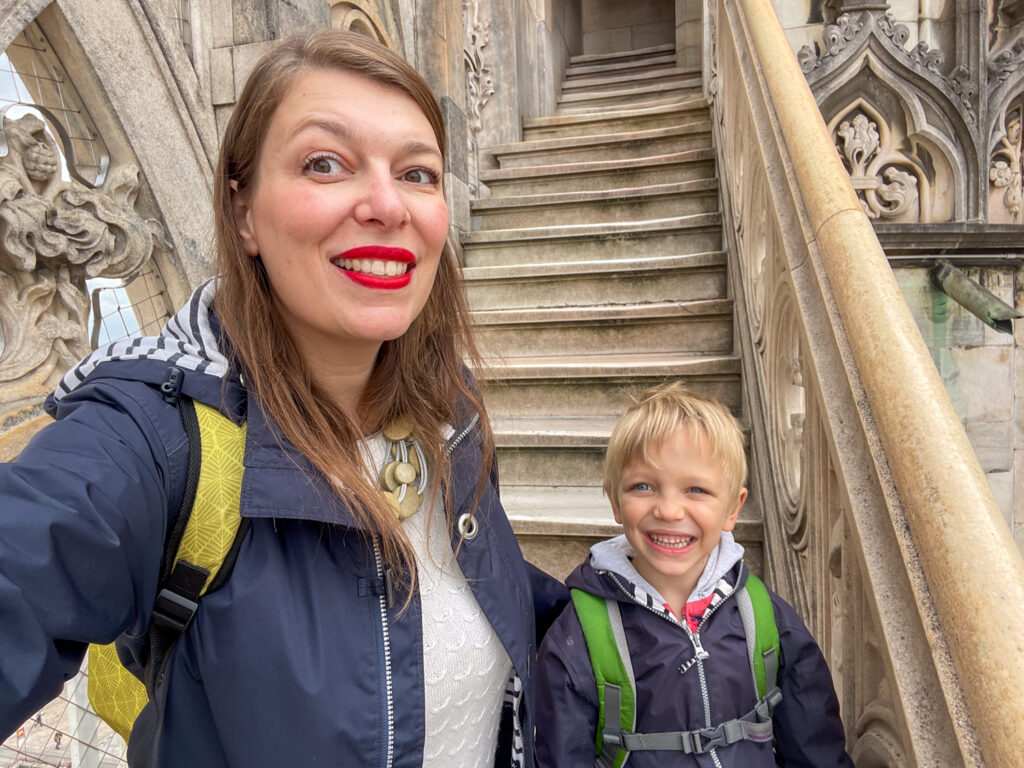
Must-See Highlights Inside the Duomo of Milan
Visiting the Duomo is an essential stop on any trip to Milan. It is the city’s most iconic symbol and offers a perfect blend of art, history, and breathtaking views.
The ticket to the Duomo usually includes access to the cathedral itself, the archaeological area, the Duomo Museum, and the Gothic church of San Gottardo in Corte, just a few steps from the main square. But the real highlight is walking on the rooftop, so I highly recommend choosing a ticket with access to the terraces.
I’ll be honest: my son and I largely skipped the cathedral’s interior because we were so excited to take in the panoramic views from above. Strolling across the roof of the Duomo, surrounded by spires, statues, and ornate pinnacles, provides a whole new perspective on Milan. From up there, you can spot intricate details almost invisible from the ground.

The Cathedral: What to See Inside
The Duomo of Milan is an integral part of the city’s religious and artistic heritage. Upon entering, you are greeted by a vast, awe-inspiring space divided into five grand naves supported by 52 towering pillars.
Every corner of the cathedral tells a unique story, filled with intricate details that warrant a slow exploration. If you’re interested in learning more, I highly recommend booking a guided tour of the Duomo of Milan. Many fascinating elements come to life when someone explains their significance.
For instance, there are more than fifty stained-glass windows, each illustrating scenes from the Bible. These windows are not merely decorative. They were created to teach the Gospel and Old Testament stories to those who could not read.
Another intriguing feature is the sundial, crafted in 1786 by astronomers from Milan’s Brera Observatory. This slim brass line, set into the floor, marks the precise hour using sunlight that enters through a small hole in the Cathedral’s wall.
Among the various chapels, the Chapel of San Giovanni Bono was constructed to block off a secondary entrance to the square, once used as a shortcut. Meanwhile, the Altar of the Presentation of the Virgin is renowned for its clever use of perspective, fitting an entire temple scene into a limited space.
These are just a few of the stories that captured my attention. Each nave, altar, and chapel within the Duomo of Milan has its own intriguing tale. You can uncover them only with the assistance of a guide.
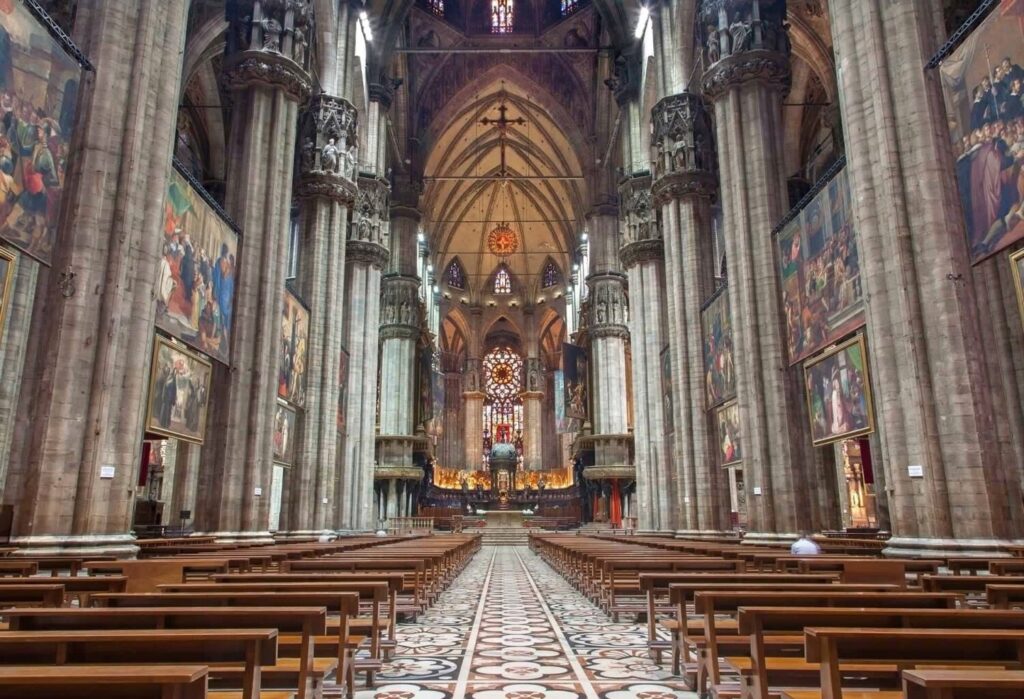
The Organ of the Duomo of Milan
When visiting the Duomo, I suggest you take a moment to admire its monumental organ. At first glance, it appears to be a single majestic instrument. Still, it is actually composed of four separate organs that work together during major celebrations.
This organ is impressive not only for its size and powerful sound but also for its beautiful decoration. The folding panels that protect the pipes are intricately painted with scenes from the lives of the Virgin Mary and various saints, making this organ a remarkable masterpiece of both art and music.
The Crypt of the Duomo of Milan
Beneath the main altar of the Duomo lies the Crypt of Charles Borromeo. His body is preserved in a silver urn at the centre of a chapel adorned with intricate reliefs depicting significant moments from his life.
In the past, this crypt served as a venue for winter religious services, as it remained warmer than the cathedral above.
If you look towards the altar, you’ll notice a small red light marking the spot where one of the nails from the Crucifixion is kept.
Hanging from the ceiling is an intriguing piece of hessian cloth known as the Sacco del Giudizio Universale (the Sack of the Last Judgment), which, according to legend, will only fall to the ground at the end of the world.
The Archaeological Area of the Duomo of Milan
From the crypt, you can access the archaeological area, which is included in your entrance ticket. Here, you’ll find the remains of the early Christian Baptistery of San Giovanni alle Fonti and the Basilica of Santa Tecla. These ancient sites were uncovered in the 1960s during excavation work for the Milan metro.
One of the most fascinating discoveries was a collection of 222 ancient coins, likely offerings left by those being baptised. This collection links to centuries of spiritual tradition beneath the city.
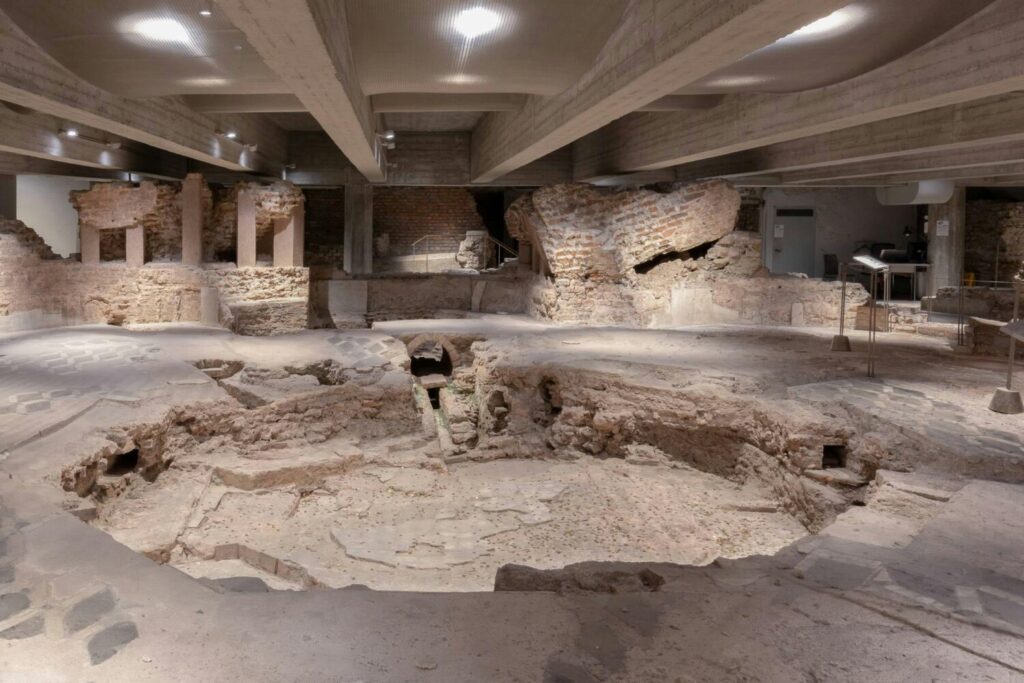
What to See in the Duomo Museum of Milan
The Duomo Museum is inside the Royal Palace, right next to the cathedral, covering an expansive area of 2,000 square meters. Within the museum, you can explore an impressive collection of architectural models, statues, paintings, tapestries, stained glass, and even terracotta and plaster casts.
Among the exhibits are original statues removed from the cathedral’s facade to protect them from weathering. One of the most fascinating sections is dedicated to wooden and plaster models of the spires, which highlight the intricate and challenging nature of the Lombard Gothic style of the Duomo.
The museum’s layout follows a chronological path, tracing the remarkable story of the cathedral’s construction as a collective effort. This project involved collaboration among artists and workshops with various styles, all united under a monumental vision.
The final section of the Duomo Museum focuses on Charles Borromeo, one of the most influential religious figures in Milan and northern Italy. His legacy extends beyond the city, even influencing the creation of other sacred sites, such as the Sacro Monte of Varallo Sesia in Piedmont.
What to See from the Rooftop Terraces of the Milan Duomo
The most captivating aspect of the Milan Duomo is undoubtedly its rooftop terraces. You can really walk on the cathedral’s roof, surrounded by spires and intricate stonework. This is an experience that is not to be missed in Milano.
In my opinion, this is the highlight of the visit, not only because of the stunning view over the Piazza del Duomo but also because of the chance to admire the cathedral’s statues and pinnacles up close. From this vantage point, you’ll notice details completely hidden from the street level.
The Duomo features an impressive 135 spires and is adorned with over 3,400 unique statues. Among these, the Guglia Maggiore stands out. It was completed between 1765 and 1770 and is crowned by Milan’s iconic golden Madonnina statue.
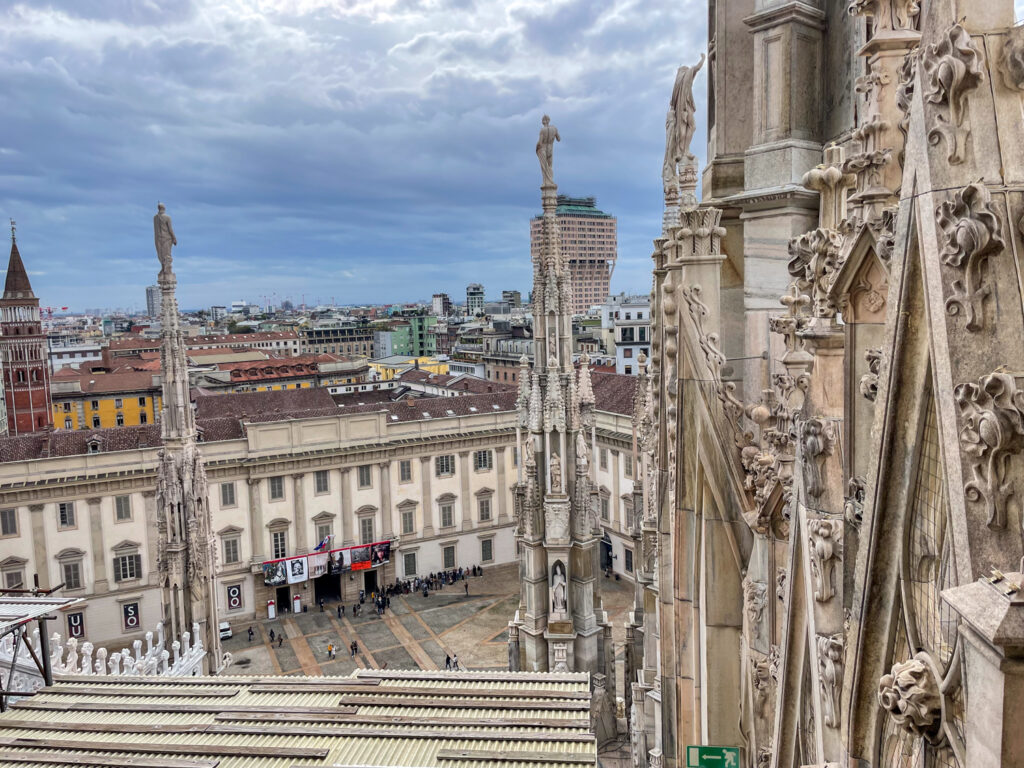
The Madonnina Statue
The Madonnina, perched atop Milan’s Duomo, is the city’s most iconic symbol and a cherished landmark for all Milanese residents. Located on the Guglia Maggiore, the tallest of the cathedral’s 135 spires, she stands 108.5 meters above ground.
Officially known as the Madonna Assunta, the statue was installed on December 30, 1774. Made of gilded copper, she is just over four meters tall and weighs nearly a ton. Thanks to her height and golden sheen, the Madonnina is visible from many points across the city, and for a long time, she was the highest point in Milan.
To uphold the tradition that no structure in Milan should exceed the height of the Madonnina, replicas of the statue have been placed atop the city’s tallest skyscrapers, including the Pirellone, the Bosco Verticale, and Torre Isozaki.
However, the Madonnina is more than just a religious figure; she is also a civic symbol. During the Cinque Giornate uprising of 1848, two patriots climbed up and placed the Italian flag on the statue to commemorate the end of Austrian occupation. Even today, the Italian flag is flown from her halberd on special occasions.
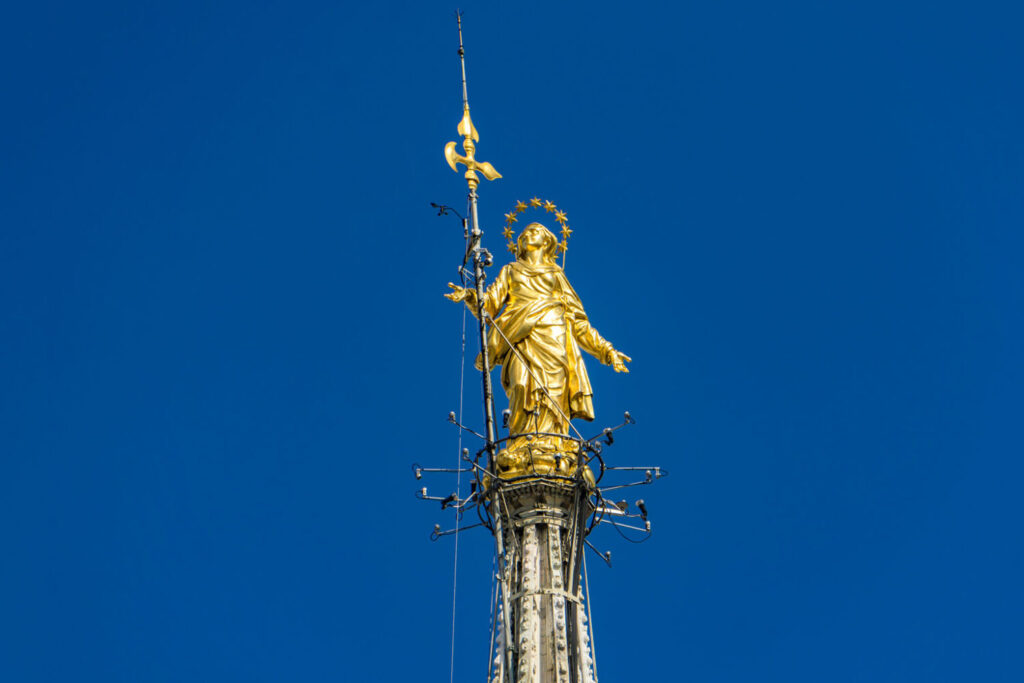
The Statues and Spires of Milan Cathedral
The Milan Cathedral features approximately 3,400 statues across its facades, spires, and terraces. These figures represent saints, animals, allegorical characters, and fantastic creatures, each imbued with specific symbolism. They really transform the cathedral into a captivating stone book waiting to be discovered.
Among the most notable statues is La Legge Nuova, sculpted by Camillo Pacetti in 1810, positioned above the central door. According to tradition, this statue may have inspired the design of the Statue of Liberty in New York.
Practical Information for Visiting the Duomo of Milan and the Panoramic Terraces
The Duomo di Milano is one of the city’s most iconic landmarks and deserves a well-planned visit. Before entering, it is important to dress respectfully, as it is a place of worship.
To avoid crowds, I recommend visiting early in the morning or shortly before closing time and trying to avoid weekends if possible. Ticket prices vary based on the areas you wish to explore and whether you choose to access the terraces by lift or stairs.
You can find more detailed explanations and suggestions on when and how to buy tickets in the dedicated paragraph below.
How to Dress for Your Visit to Milan Cathedral
The Duomo di Milano is a place of worship, so a modest dress code is required, just as in all churches. Please avoid bare shoulders, exposed midriffs, and very short shorts.
Although clothing checks are usually not strict, bringing a shawl or a t-shirt to cover up respectfully if you wear a tank top, especially during the summer, is a good idea.
Routine security checks are conducted at the entrance, and bags will be inspected. Bulky backpacks are not allowed inside. The cathedral has no cloakroom, but you can find nearby luggage storage services, such as Radical Storage.
If you plan to visit the terraces, keep in mind that the second-level terrace is not flat. It has a slight slope as it forms the roof of the central nave. Wearing comfortable clothing and non-slip shoes is essential for your safety and enjoying this unique experience.
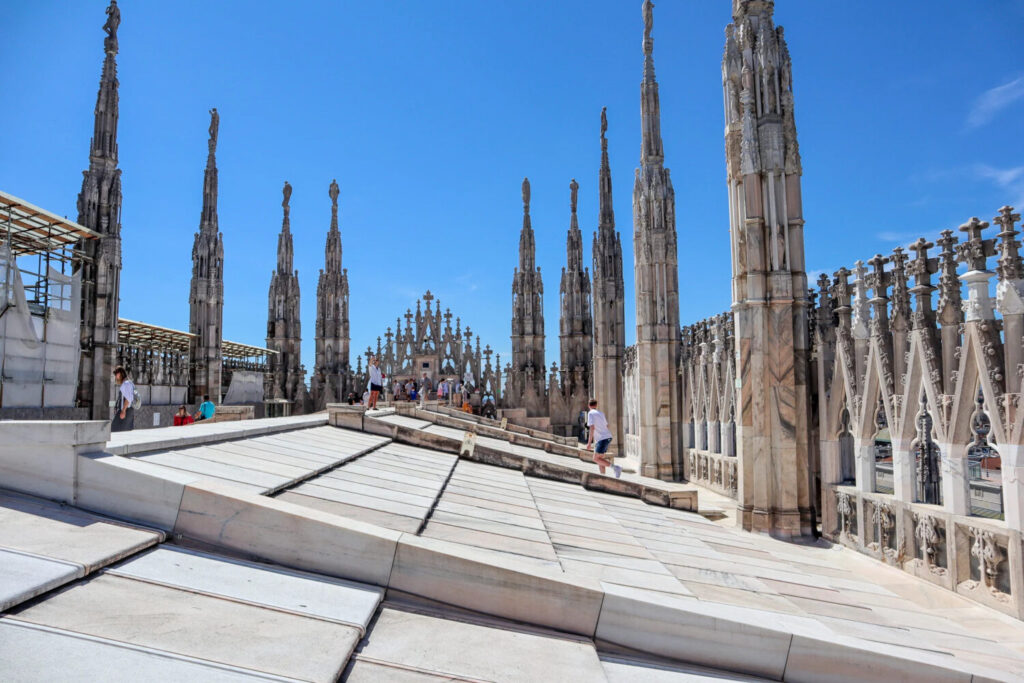
Stairs or Elevator to the Duomo Terraces: Which to Choose
You can reach the terraces of the Duomo either by foot, climbing about 250 steps, or more comfortably by elevator, depending on how much time or energy you have. The last time I visited, I chose the elevator because climbing all those steps with my son would have been quite tiring.
Once you reach the top, the first panoramic walkway begins at a height of 31 meters. From there, you can stroll around the entire perimeter of the cathedral.
Then, two short but steep stairs lead you to the second level at 45 meters, where there is the central terrace above the main nave. This terrace is not flat, but it has a slight slope. So, wearing comfortable shoes is essential for walking safely.
If you choose the elevator instead of the stairs, please note that there is a slight difference in the ticket price.
Opening Hours of Milan Cathedral and the Terraces
The Duomo di Milano is one of the most popular attractions in the city, so expect long queues any day of the week. The cathedral and its terraces are open to visitors daily from 10:00 am to 4:00 pm. During the summer, there are occasionally special evening openings for the terraces. Check the official website or the visit calendar for updates.
To avoid crowds and make the most of your visit, I recommend arriving right at opening time in the morning or during the last hour before closing. Booking a skip-the-line ticket can also enhance your experience. Weekends and public holidays are the busiest times to visit, so, if possible, plan your visit for other days.
For Catholic worshippers, entrance to the Duomo is free for prayer and religious services every day from 8:00 am to 6:00 pm. However, access is supervised by security staff, and worshippers are not allowed to visit the terraces or the Duomo Museum without a proper ticket. So don’t use it as a shortcut to avoid paying admission.
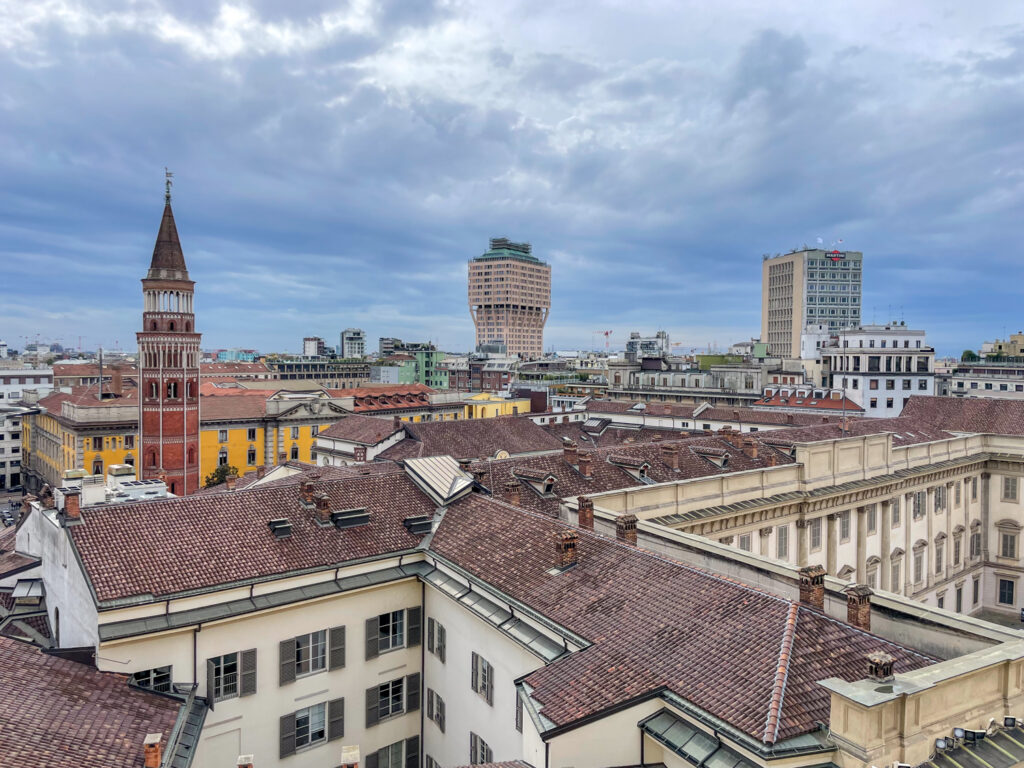
Understanding Ticket Prices for the Duomo di Milano: Which One You Should Choose
You can choose from several types of tickets to visit the Duomo di Milano, depending on which areas you want to explore. The basic entrance ticket starts at around €20, granting access to the cathedral, the archaeological area, and the Duomo Museum. However, this ticket doesn’t include access to the terraces, which must be purchased separately.
In my opinion, the most spectacular part of the visit is seeing the Duomo from above, where you can enjoy close-up views of the statues and panoramic vistas of Milan. I strongly recommend opting for the full ticket that includes access to the terraces, ideally with elevator access. For this type of ticket, expect to pay about €30 per person.
If you’re only interested in visiting the terraces and not the cathedral or museum, you can purchase terraces-only tickets online.
While tickets are not cheap, discounts are available for children and teens. Additionally, Milan City Pass tourist card includes access to the terraces. Regardless of which ticket you choose, buying online is always the best option to skip the queues.
Where to Buy Duomo of Milan Tickets Online
To save a few euros, consider purchasing tickets directly from the official Duomo di Milano website. However, be aware that availability tends to sell out quickly, especially if you book at the last minute.
If the official site is sold out, you can turn to specialised resellers like GetYourGuide, Tiqets, or Viator. These platforms buy large batches of tickets daily and resell them. For this reason, you often find availability even when the official site is fully booked.
Personally, I prefer using these resellers when I travel. They allow me to skip the queues and keep all my tickets conveniently stored in a smartphone app. To ensure you get the best price, I recommend checking and comparing ticket prices across different reseller sites before making a purchase. Prices can vary a lot for the same ticket types.
Why a Guided Tour is the Best Way to Visit the Duomo of Milan
I’ll admit that I’m usually not very interested in visiting churches. However, everything changes when you explore them with a guide. Having a real person share stories, secrets, and little-known facts brings the place to life, making the experience much richer and more engaging.
This is especially true for the Duomo of Milan. A guided tour is the best way to truly appreciate its historical and artistic significance. It helps you notice every detail and maximises your time, as there’s no need to wander around trying to find the chapels or statues that interest you most.
Another great advantage is the skip-the-line access. With a guided tour, you can avoid long waits at the entrance and dive straight into your visit. The best part is that it often costs just a little more than a regular ticket, making it a smart choice.
How to Get to Milan Cathedral
Milan is well-connected to all major Italian cities. I have often travelled there by train because it is convenient, fast, and budget-friendly. You can choose between high-speed trains that take you to the city centre quickly or regional trains, which are usually cheaper but take longer.
Once in Milan, reaching the Duomo is easy via public transport, including buses and the metro. The Duomo metro station is in front of the cathedral and is served by the M1 (red) and M3 (yellow) lines. No matter where your hotel is situated, a few changes will get you to Piazza del Duomo without needing a car.
If you are driving, I highly recommend parking on the outskirts and using public transport to reach the centre. The historic centre is a restricted traffic zone (ZTL) with regulated access. Parking can be expensive and difficult to find.
Duomo di Milano
Piazza Duomo, 20122 Milano
What to See Near the Duomo of Milan Within Walking Distance
Just steps away from the Duomo di Milano, there is plenty to explore, all within walking distance. The stunning Galleria Vittorio Emanuele II is next to the cathedral, one of Milan’s most iconic spots. Its elegant shops, historic cafés, and impressive glass-and-iron dome make it perfect for a leisurely stroll.
After leaving the Galleria, you can reach Piazza della Scala in just a few minutes. This square is home to the world-famous Teatro alla Scala, an opera lover’s dream. Even if you do not catch a performance, the Teatro alla Scala Museum is worth a visit. It showcases costumes, musical instruments, and temporary exhibits about the theatre’s rich history.
Also located in Piazza Duomo is the Museo del Novecento. It’s ideal if you are interested in modern and contemporary art. From there, you can enjoy a beautiful view of the cathedral itself.
If you have more time, consider walking to Sforza Castle, one of Europe’s most important Renaissance fortresses. Surrounding it is the lush greenery of Parco Sempione. Alternatively, you can get lost in the charm of the Brera district. Its cobbled streets and the famous Pinacoteca di Brera art gallery are another must-see in Milan.
Where to stay in Milan
Milan is one of Italy’s largest cities and, for this reason, offers every possible type of accommodation. Park Hyatt Milano is the most luxurious hotel in the heart of the fashion district in Milan. It’s near the Cathedral and La Scala Theatre, making it an excellent tourist location. For cheaper yet elegant accommodation, try Aparthotel Meneghino, within walking distance of Milan Cathedral and the Milan Fashion District. B&B Le Dimore Suites Milano is also a great option with a terrace and views of the inner courtyard.
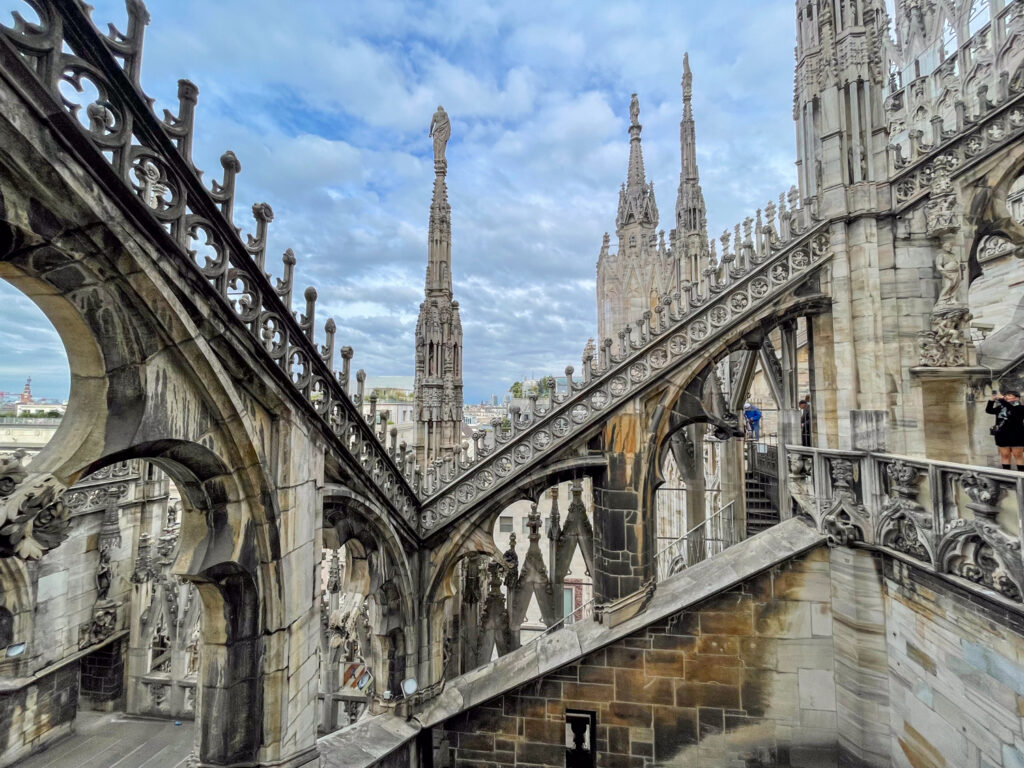
Final Thoughts: Why The Duomo is a Must-Visit Landmark in Milan
Visiting the Duomo di Milano is like embarking on a journey through history and art simultaneously. If you’re planning a trip to Milan, this Gothic masterpiece must be included in your itinerary.
For those who have already visited, you know how it never fails to impress, whether it’s a statue you overlooked, a stained glass window that catches the light in an unexpected way, or an architectural detail that previously escaped your notice.
Then there are the terraces: from this vantage point, Milan spreads out beneath you, offering a breathtaking panorama that alone justifies the visit.
Feel free to share your experiences in the comments. What impressed you most about this article? If you’ve visited the Duomo, tell me what stayed with you after your experience. I’m eager to hear what drew you to the Duomo and what touched your heart during your visit.
